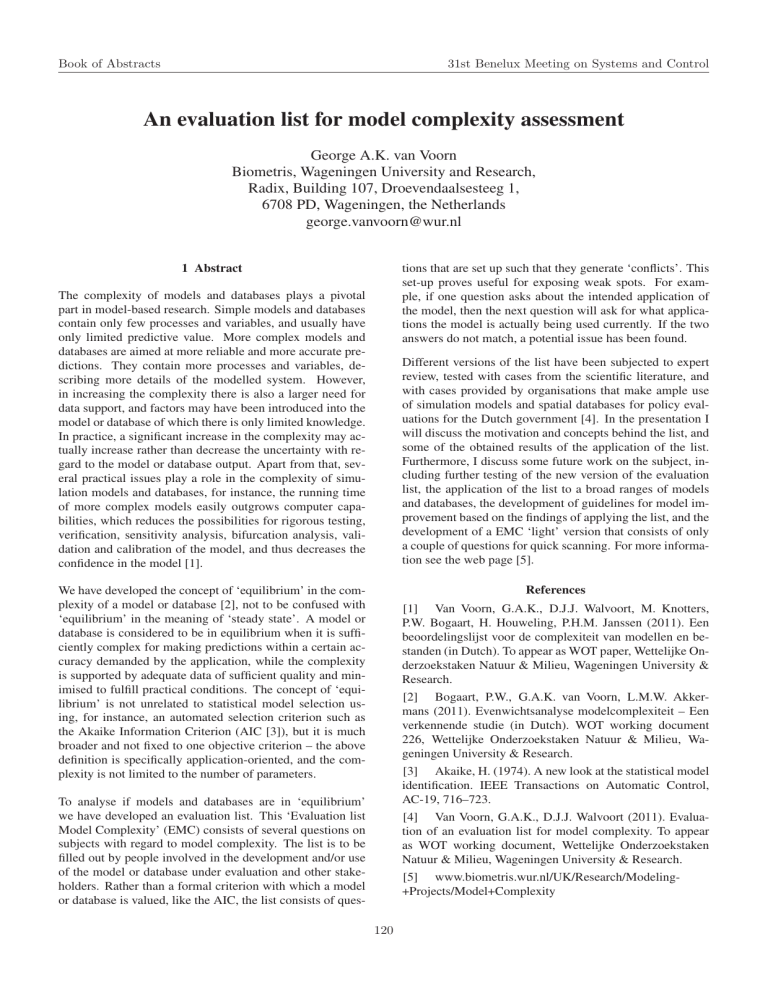
Book of Abstracts
31st Benelux Meeting on Systems and Control
An evaluation list for model complexity assessment
George A.K. van Voorn
Biometris, Wageningen University and Research,
Radix, Building 107, Droevendaalsesteeg 1,
6708 PD, Wageningen, the Netherlands
[email protected]
1 Abstract
tions that are set up such that they generate ‘conflicts’. This
set-up proves useful for exposing weak spots. For example, if one question asks about the intended application of
the model, then the next question will ask for what applications the model is actually being used currently. If the two
answers do not match, a potential issue has been found.
The complexity of models and databases plays a pivotal
part in model-based research. Simple models and databases
contain only few processes and variables, and usually have
only limited predictive value. More complex models and
databases are aimed at more reliable and more accurate predictions. They contain more processes and variables, describing more details of the modelled system. However,
in increasing the complexity there is also a larger need for
data support, and factors may have been introduced into the
model or database of which there is only limited knowledge.
In practice, a significant increase in the complexity may actually increase rather than decrease the uncertainty with regard to the model or database output. Apart from that, several practical issues play a role in the complexity of simulation models and databases, for instance, the running time
of more complex models easily outgrows computer capabilities, which reduces the possibilities for rigorous testing,
verification, sensitivity analysis, bifurcation analysis, validation and calibration of the model, and thus decreases the
confidence in the model [1].
Different versions of the list have been subjected to expert
review, tested with cases from the scientific literature, and
with cases provided by organisations that make ample use
of simulation models and spatial databases for policy evaluations for the Dutch government [4]. In the presentation I
will discuss the motivation and concepts behind the list, and
some of the obtained results of the application of the list.
Furthermore, I discuss some future work on the subject, including further testing of the new version of the evaluation
list, the application of the list to a broad ranges of models
and databases, the development of guidelines for model improvement based on the findings of applying the list, and the
development of a EMC ‘light’ version that consists of only
a couple of questions for quick scanning. For more information see the web page [5].
References
We have developed the concept of ‘equilibrium’ in the complexity of a model or database [2], not to be confused with
‘equilibrium’ in the meaning of ‘steady state’. A model or
database is considered to be in equilibrium when it is sufficiently complex for making predictions within a certain accuracy demanded by the application, while the complexity
is supported by adequate data of sufficient quality and minimised to fulfill practical conditions. The concept of ‘equilibrium’ is not unrelated to statistical model selection using, for instance, an automated selection criterion such as
the Akaike Information Criterion (AIC [3]), but it is much
broader and not fixed to one objective criterion – the above
definition is specifically application-oriented, and the complexity is not limited to the number of parameters.
[1] Van Voorn, G.A.K., D.J.J. Walvoort, M. Knotters,
P.W. Bogaart, H. Houweling, P.H.M. Janssen (2011). Een
beoordelingslijst voor de complexiteit van modellen en bestanden (in Dutch). To appear as WOT paper, Wettelijke Onderzoekstaken Natuur & Milieu, Wageningen University &
Research.
[2] Bogaart, P.W., G.A.K. van Voorn, L.M.W. Akkermans (2011). Evenwichtsanalyse modelcomplexiteit – Een
verkennende studie (in Dutch). WOT working document
226, Wettelijke Onderzoekstaken Natuur & Milieu, Wageningen University & Research.
[3] Akaike, H. (1974). A new look at the statistical model
identification. IEEE Transactions on Automatic Control,
AC-19, 716–723.
To analyse if models and databases are in ‘equilibrium’
we have developed an evaluation list. This ‘Evaluation list
Model Complexity’ (EMC) consists of several questions on
subjects with regard to model complexity. The list is to be
filled out by people involved in the development and/or use
of the model or database under evaluation and other stakeholders. Rather than a formal criterion with which a model
or database is valued, like the AIC, the list consists of ques-
[4] Van Voorn, G.A.K., D.J.J. Walvoort (2011). Evaluation of an evaluation list for model complexity. To appear
as WOT working document, Wettelijke Onderzoekstaken
Natuur & Milieu, Wageningen University & Research.
[5] www.biometris.wur.nl/UK/Research/Modeling+Projects/Model+Complexity
120












